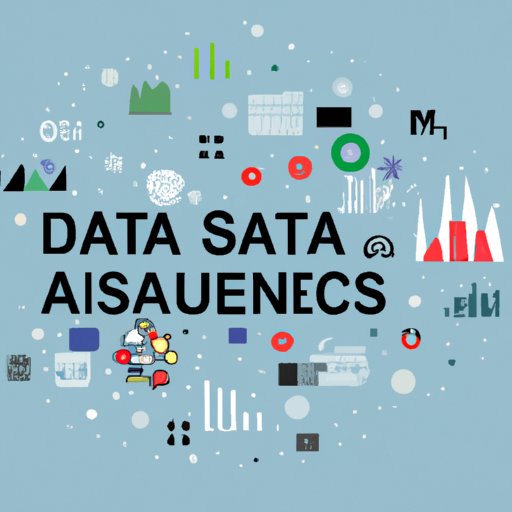Introduction
Data science analytics is an increasingly important tool for businesses to gain valuable insights into their customers and operations. It is a process that involves collecting and analyzing large amounts of data to draw meaningful conclusions and predictions. This article will explore the definition, purpose, and benefits of data science analytics, as well as the different types, how to utilize it in businesses, the role of machine learning, and opportunities for the future.

An Overview of Data Science Analytics
Data science analytics is the process of using data to make decisions and predictions. It involves collecting and analyzing large amounts of data from various sources, such as customer surveys, web traffic, and business transactions. The goal is to identify patterns and trends in the data that can be used to inform business decisions and improve performance.
Data science analytics has become increasingly important in recent years due to the rise of big data, which has made it easier for businesses to collect and analyze large amounts of data. As a result, data science analytics has become an essential tool for businesses to gain valuable insights into their customers and operations.
Exploring the Benefits of Data Science Analytics
Data science analytics provides numerous benefits to businesses, including increased efficiency, more accurate predictions, and improved decision-making. Let’s take a closer look at some of these benefits.
Increased Efficiency
Data science analytics can help businesses increase efficiency by automating tedious tasks and reducing the amount of time spent on manual processes. For example, data science analytics can be used to automate customer segmentation, which can save businesses time and money.
More Accurate Predictions
Data science analytics can also help businesses make more accurate predictions. By analyzing large amounts of data, businesses can identify patterns and trends that can be used to predict customer behaviors and market movements. This can help businesses plan ahead and make better decisions.
Improved Decision-Making
Data science analytics can also help businesses make better decisions. By analyzing data, businesses can gain insight into customer behavior and market trends, which can help them make more informed decisions. Additionally, data science analytics can be used to identify areas for improvement, allowing businesses to optimize their operations and maximize profits.
Understanding the Different Types of Data Science Analytics
Data science analytics can be divided into three main categories: descriptive analytics, predictive analytics, and prescriptive analytics. Let’s take a closer look at each one.
Descriptive Analytics
Descriptive analytics is the process of collecting and analyzing data to describe past events. It is used to identify patterns and trends in the data, which can be used to gain insights into customer behaviors and market movements.
Predictive Analytics
Predictive analytics is the process of using data to make predictions about future events. It uses statistical models to identify patterns and trends in the data, which can be used to make predictions about customer behaviors and market movements.
Prescriptive Analytics
Prescriptive analytics is the process of using data to recommend actions. It combines descriptive and predictive analytics to identify potential solutions and recommend the best course of action. This can be used to optimize operations and maximize profits.

How to Utilize Data Science Analytics in Businesses
Data science analytics can be used in businesses to gain valuable insights into their customers and operations. To do this, businesses need to identify relevant data, collect and clean the data, and model and analyze the data. Let’s take a closer look at each step.
Identifying Relevant Data
The first step in utilizing data science analytics is to identify relevant data. This includes data from customer surveys, web traffic, and business transactions. Once the data has been identified, it can be collected and cleaned.
Collecting and Cleaning Data
The next step is to collect and clean the data. This involves gathering the data from various sources and organizing it into a usable format. Additionally, any missing or incorrect data needs to be corrected to ensure accuracy.
Modeling and Analyzing Data
Once the data has been collected and cleaned, it can be modeled and analyzed. This involves using statistical models and algorithms to identify patterns and trends in the data, which can be used to make predictions and recommendations.
The Role of Machine Learning in Data Science Analytics
Machine learning is a type of artificial intelligence (AI) that can be used to automate tasks and enhance performance. It involves using algorithms and statistical models to identify patterns and trends in data, which can be used to make predictions and recommendations. Additionally, machine learning can be used to improve accuracy by identifying and correcting errors in data.

Identifying Opportunities for Data Science Analytics
Data science analytics can be used to identify trends, monitor performance, and increase profitability. For example, data science analytics can be used to identify customer segments and target marketing campaigns, as well as monitor customer satisfaction and identify areas for improvement.

Examining the Future of Data Science Analytics
The future of data science analytics is bright. With the rise of big data and artificial intelligence (AI), businesses will have access to more data than ever before. Additionally, automation and personalization will become increasingly important, as will cloud computing and security.
Conclusion
Data science analytics is a powerful tool for businesses to increase efficiency, improve decision-making, and gain insights into customer behaviour. It involves collecting and analyzing large amounts of data to identify patterns and trends, which can be used to make predictions and recommendations. Additionally, machine learning can be used to automate tasks and enhance performance. As big data and AI continue to grow, data science analytics will become increasingly important for businesses to succeed.
(Note: Is this article not meeting your expectations? Do you have knowledge or insights to share? Unlock new opportunities and expand your reach by joining our authors team. Click Registration to join us and share your expertise with our readers.)
